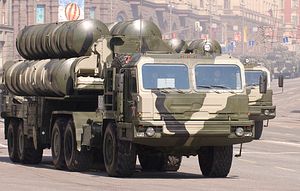Russia has completed delivery of the first regimental set of S-400 Triumf advanced interceptor-based air defense systems (NATO reporting name: SA-21 Growler) to China under a 2014 government-to-government contract, an unnamed Russian official told TASS news agency on May 10.
According to the source, the last of three ships carrying different components of the air defense systems arrived in China this month. “The last batch of military equipment for the first regimental set of S-400 systems has been delivered by sea from Ust-Luga, the Leningrad Region, to China,” the source said. “The ship has brought the equipment not damaged during a December storm in the English Channel and the damaged equipment after repairs.”
As I reported previously, the first two Russian cargo ships carrying the bulk of the equipment, including launchers and mobile radar systems, arrived in China in April. Russian personnel will begin handing over the equipment for induction into the People’s Liberation Army at the end of May. The whole process is expected to take about two months. Neither China nor Russia have publicly confirmed the delivery of the weapons systems.
The exact number of S-400 air defense systems as well as the specific missile types sold to China remain unknown. Beijing has reportedly ordered four to six S-400 regimental sets for an estimated $3 billion; however, Russian sources recently spoke only of two regiments. (Given the purported $3 billion price tag, two regimental units seems more likely.) As I explained in February 2018:
The standard S-400 battery consists of four transporter erector launchers (TELs), four launch tubes per TEL, in addition to target acquisition and engagement (fire control) radar systems and a command post. (With an additional fire control radar system, a battery can consist of up to 12 TELs.) Two batteries make up a S-400 battalion (also known as a S-400 division), whereas a S-400 regiment consists of two battalions.
As a result, total TELs delivered under the contract could range anywhere between 30 to 200. The S-400 is touted as one of the most effective long-range air defense systems in the world, although it has never been tested under actual combat conditions. I explained the S-400s basic technical characteristics including its various surface-to-air missiles:
In comparison to its predecessor, the S-300, the S-400 air defense system features an improved radar system and updated software; it can purportedly fire four new types of surface-to-air (SAM) missiles in addition to the S-300’s 48N6E, a vertical tube launched, solid fuel, single stage SAM with an estimated range of 150 kilometers (93 miles), and the improved 48N6E2 missile with a reported range of 195 kilometers (121 miles).
One of the S-400’s new missiles is the so-called 40N6E SAM with an estimated operational range of 400 kilometers (248.5 miles) and an altitude of up to 185 kilometers (607,000 feet). The missile is reportedly capable of exo-atmospheric interception of intermediate-range ballistic missile warheads in their terminal phase. However, it is unclear whether the weapon is operational in Russia yet and no images of the 40N6E SAM have surfaced so far.
The S-400 is also armed with an improved variant of the 48N6E2 with an alleged range of 250 kilometers (160 miles). The air defense system can also fire two additional missiles, the 9M96E and 9M96E2 with respective ranges of 40 km (25 miles) and 120 km (75 miles). Improved S-300 air defense systems such as the S-300PMU-2 Favorite … can purportedly also fire the 9M96E and 9M96E2.
According to unconfirmed reports, the first regimental unit delivered to China will be armed with the 48N6E2, a missile already in service with existing PLA S-300 regiments. Subsequent deliveries will allegedly include the 40N6E.































